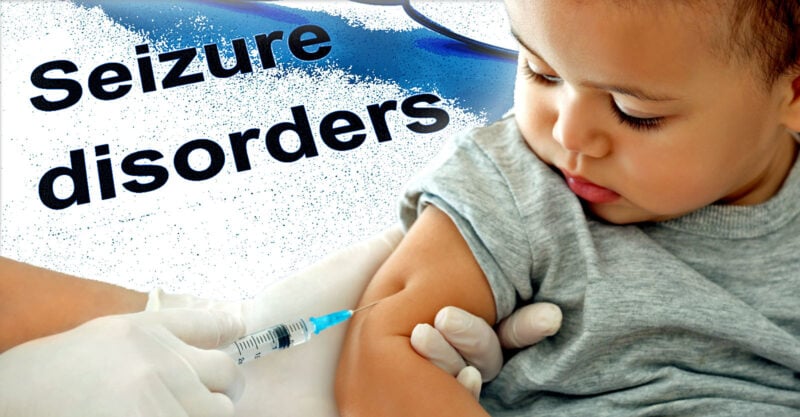Health
FDA Finds ‘Safety Signal’ in Children 2-5 After COVID mRNA Vaccines
A new study led by U.S. Food and Drug Administration researchers has identified a potential safety signal linking mRNA COVID-19 vaccines to seizures in children ages 2-5 years old, but the study’s authors cautioned that definitive conclusions cannot be drawn without more rigorous observational research.

This article originally appeared on childrenshealthdefense.org and was republished with permission.
Guest post by John-Michael Dumais
A new preprint study led by the U.S. Food and Drug Administration (FDA) has detected a potential “safety signal” for seizures and convulsions in young children after receiving the monovalent Pfizer or Moderna mRNA COVID-19 vaccines.
Researchers observed the condition in children ages 2-4 for the Pfizer vaccine, and ages 2-5 for the Moderna vaccine. The total number of cases was 72, with over 50% meeting the definition for febrile seizures.
The median time between vaccination and seizures or convulsions was two days, with 32% occurring the day of or the day after vaccination. All seizures and convulsions took place within seven days of vaccination.
The signal emerged through near real-time surveillance of more than 4 million vaccinated children.
The researchers of the preprint study cautioned that the results “should be interpreted carefully given study limitations.”
The study also identified a myocarditis/pericarditis safety signal in mostly male children 12-17 years old. However, since each of these conditions were a “known adverse outcome,” according to the researchers, they did not conduct any further follow-up.
Data for the study were collected through health claims records from CVS Health, Optum and Carelon Research, which participate in the FDA’s Center for Biologics Evaluation and Research, and supplemented with data from state and local immunization information systems databases.
The study covered reports through January, February or March of this year — as little as 6 months after the approval of vaccinations for younger children.
The study reviewed 21 pre-specified health outcomes after exposure to the Pfizer, Moderna and Novavax monovalent COVID-19 vaccines in children 6 months to 17 years, and identified only these two safety signals as statistically significant.
Children receiving a bivalent COVID-19 vaccine were not included in the review. The FDA authorized Moderna’s and Pfizer’s updated bivalent vaccines in December 2022, for infants as young as 6 months.
Since Novavax’s shot was approved for emergency use for persons 12 and older, on Oct. 3, 2023, the researchers reviewed only 43 subjects who took two doses of the Novavax product — compared to over 300,000 and 8 million total doses for Moderna’s and Pfizer’s, respectively — and were therefore unable to collect enough data for meaningful analysis.
The case for caution around interpretation of results
The study authors note the results do not establish a causal connection between vaccination and the observed outcomes.
First, despite the data described above, the authors concluded they did not find a strong pattern of clustering near the date of vaccination (day 0 or 1).
Second, they did not adjust for confounding factors such as prior medical history, existing infections or other variables. Febrile seizures, for example, typically occur in children 6 months to 5 years old when they have a fever over 100.4°F. Most febrile seizures last less than 15 minutes and are not life-threatening.
Third, the signal disappeared altogether when they used the 2022 background rate for seizures and convulsions rather than the 2020 background rate. This suggests the possibility that there may be other factors at work other than the vaccines, though the researchers did not investigate further.
A search of the Vaccine Adverse Event Reporting System (VAERS) database showed 70 cases of seizures and 20 cases of convulsions in children 2-5 following COVID-19 vaccination. Assuming a conservative underreporting factor of 40, that could mean well over 3,000 cases occurred.
As the current study did not consult the VAERS database, it remains unknown how many of the VAERS reports were studied. However, the FDA study states that this safety signal had “not been previously reported for this age group in active surveillance studies of mRNA COVID-19 vaccines.”
The researchers called for further observational research and continued monitoring.
Over half of U.S. children have not received a COVID vaccine
The Centers for Disease Control and Prevention (CDC) reports that as of May, 2.2 million children ages 6 months to 4 years had received at least one dose of a COVID-19 vaccine — about 13% of that population.
Among children ages 12-17, 17.9 million — or 68% —received at least one dose, with 2.6 million fewer opting for the second dose, according to the CDC.
Approximately 56% of children 6 months to 17 years — a total of 40.5 million — have not received a first dose of the COVID-19 vaccine.
The FDA granted Emergency Use Authorization for the Pfizer vaccine for children 16-17 years old on Dec. 11, 2020, and for children 12-15 years old on May 10, 2021.
On Aug. 23, 2021, the Pfizer vaccine, then renamed Comirnaty, received full FDA approval for children 16-17 years old.
Vaccination for children under 12 began on Nov. 2, 2021, when the CDC recommended Pfizer’s vaccine for children ages 5-11.
The FDA authorized the emergency use of the PfizerBioNTech COVID-19 vaccine for the same age group on Oct. 29, 2021.
On June 8, 2022, the CDC expanded the eligibility for COVID-19 vaccination to include all children 6 months to 5 years of age.
The CDC now recommends COVID-19 vaccines for everyone 6 months and older.
-

 Health3 days ago
Health3 days agoThe Shocking Truth About Skin Cancer: What You’re Not Being Told About the Sun
-

 News1 day ago
News1 day agoRAY EPPS EXPOSED: Never-Before-Released FBI Interview Uncovered
-

 News7 hours ago
News7 hours agoFBI Again Warns of Potential Terror Attack in US, “Not That Different” from Concert Attack in Russia
-

 News2 days ago
News2 days agoJoe Rogan Goes Quiet as Tucker Carlson Drops Bone-Chilling Reality






























